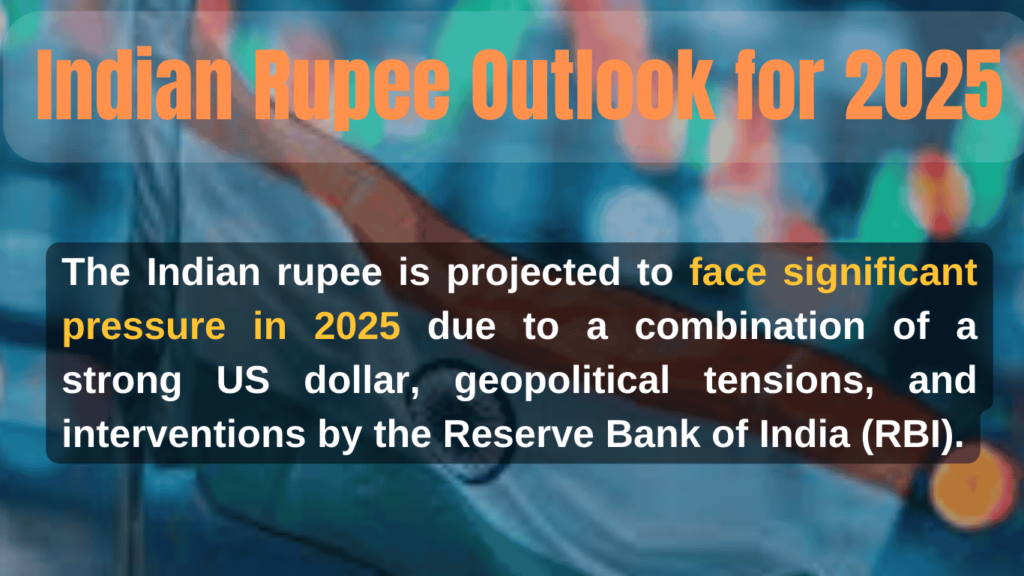Indian Rupee Outlook for 2025

In Short
The Indian rupee is projected to face significant pressure in 2025 due to a combination of a strong US dollar, geopolitical tensions, and interventions by the Reserve Bank of India (RBI). Experts anticipate that these factors will contribute to continued depreciation of the rupee, which has already been on a downward trend.
Key Points
- RBI Interventions: The Reserve Bank of India is expected to actively intervene in the currency market to manage volatility, potentially allowing for controlled depreciation of the rupee.
- Influence of the US Dollar: A stronger dollar, driven by US Federal Reserve policies and geopolitical factors, is likely to exert downward pressure on the rupee.
- Recent Performance: The rupee has depreciated significantly in recent months, reaching a low of 85.6200 against the dollar, with increased volatility noted.
- Economic Indicators: Factors such as foreign portfolio investment outflows, sluggish domestic growth, and a widening trade deficit are contributing to the rupee’s challenges.
- RBI’s Dividend Impact: Despite rupee depreciation, the RBI’s dividend to the government is not expected to be adversely affected, and may even benefit from foreign exchange dynamics.
Detailed Breakdown
RBI’s Role in Currency Management
The RBI has been actively involved in stabilizing the rupee through interventions in both spot and forward markets. Recent actions include selling dollars in the forward market to mitigate extreme volatility. Experts predict that the RBI will continue this strategy, allowing for limited depreciation of the rupee if other Asian currencies also decline. This approach aims to maintain export competitiveness while controlling excessive fluctuation.
Strong Dollar Pressures
The anticipation of a stronger dollar is primarily influenced by the US Federal Reserve’s interest rate policies and the new administration’s economic strategies. As the dollar strengthens, the rupee is expected to weaken further, influenced by external economic conditions and geopolitical tensions. Aditi Gupta from Bank of Baroda emphasizes that the trajectory of the US dollar will play a critical role in the rupee’s future.
Recent Trends and Economic Indicators
The rupee has witnessed a notable depreciation, falling from 84.0837 to 85.6200 against the dollar in a two-month period. The depreciation is attributed to several headwinds, including outflows from foreign portfolio investors, a robust dollar index, and India’s sluggish economic growth. Additionally, the widening merchandise trade deficit has compounded the rupee’s challenges, resulting in increased market volatility.
Impact on RBI’s Dividends
Despite the depreciation of the rupee, experts believe that the RBI’s dividend payments to the government will remain stable. The decline in interest income from foreign currency assets is expected to be offset by increased profits from dollar sales. Harsimran Sahni from Anand Rathi Global Finance notes that depreciation could enhance the RBI’s dividends, provided the bank maintains adequate foreign exchange reserves to manage potential volatility.
Important Details & Evidence
- The rupee’s year-to-date depreciation stands at 2.72%, making it one of the least volatile currencies in Asia, largely due to timely RBI interventions.
- The RBI’s strategy will likely focus on curbing excessive volatility while allowing for gradual depreciation to support export competitiveness.
- The geopolitical landscape, especially in relation to US policies, will be a significant factor influencing currency stability.
The outlook for the Indian rupee in 2025 is shaped by a complex interplay of domestic economic conditions and international influences. The RBI’s proactive intervention strategies are crucial in managing volatility while navigating the pressures of a strengthening dollar and geopolitical uncertainties. Despite current challenges, the potential for the RBI to maintain or even increase dividend payments to the government suggests a nuanced impact of currency fluctuations on broader economic health. As such, stakeholders should remain vigilant to the evolving dynamics affecting the rupee’s trajectory.